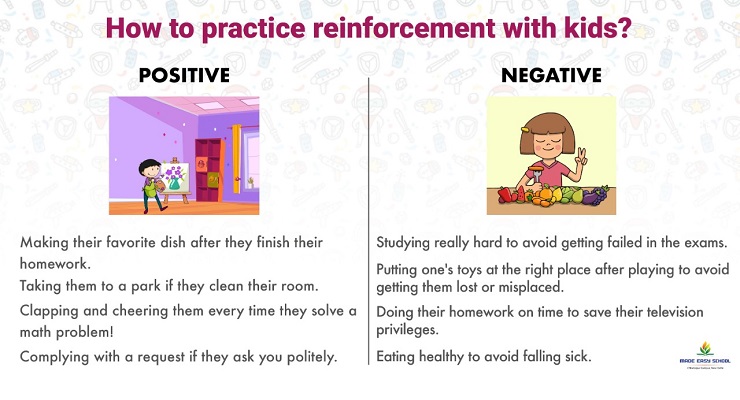POSITIVE REINFORCEMENT vs NEGATIVE REINFORCEMENT
Children don’t come with an instruction manual for how to behave according to the situation, place, and time. Specially with toddlers, it gets very important for parents to inculcate good values and behaviors in an early stage of their life. However, parents often find it difficult and confusing as to what is the RIGHT way to impart good habits/behaviors in young minds. Here in this article, we will be discussing some of the methods that can be practiced with your child for the same.
In a concept called “operant conditioning” B.F skinner explained how voluntary behaviors are learned through the effects of pleasant or unpleasant consequences for responses, that is, a person is likely to do or avoid a behavior if he/she knows the consequences of it. The idea solely depends on “If I do this, what’s in it for me?”
This theory leads us to the concept of reinforcement.
WHAT IS REINFORCEMENT?
The word reinforce itself means “to strengthen”, that is to say, reinforcement is any event or stimuli that is followed by a response, increases the probability of that response (a habit or a behaviour ) to happen again. In a simpler term, reinforcement helps a particular behaviour to occur more frequently.
ADVANTAGES OF REINFORCEMENT:
MOTIVATION: When we reinforce a behaviour or response, it will keep an individual motivated to practice that behaviour.
CONSISTENCY: Reinforcing a behaviour every time a desired response is achieved leads to consistency in repeating that behaviour again and again.
Here, we will be discussing two types of reinforcements as follows:
- POSITIVE REINFORCEMENT
- NEGATIVE REINFORCEMENT
WHAT IS POSITIVE REINFORCEMENT?
In simple terms positive reinforcement is a method used to establish a pattern of behaviour involved by addition or experiencing a pleasurable consequences or outcome after the desired response. Example: getting money for working is a perfect example of positive reinforcement as a person is getting paid (consequence) for working (desired behaviour).
HOW TO PRACTICE POSITIVE REINFORCEMENT WITH KIDS?
Positive Reinforcement is proved to be very effective method for parenting. Kids tend to finish a work or learn a behaviour more effectively if they are provided with some reward after a desired response. Here are some of the examples for the same
- Making their favourite dish after they finish their homework.
- Taking them to a park if they clean their room.
- Clapping and cheering them every time they solve a math problem!
- Complying with a request if they ask you politely
Thus, linking behaviour with pleasurable rewards will install a drive in your child to repeat that behaviour again. However, rewards are not always supposed to be materialistic. A reward for a child can be as simple as patting their back if they do good and letting them know that you do pay attention and appreciate the right things.
WHAT IS NEGATIVE REINFORCEMENT?
Negative Reinforcement is not what it sounds. Rather negative reinforcement also helps to strengthen a response or behaviour. To break it down for you, negative reinforcement is removal or escaping an unpleasant outcome. Example: wearing a sweater to avoid catching cold. In negative reinforcement a person tries to avoid a negative outcome.
HOW TO PRACTICE NEGATIVE REINFORCEMENT WITH KIDS?
Parents often confuse negative reinforcement with punishment but that is clearly not the case here. Negative reinforcement is proved to be very effective and helps learn a behaviour faster. Children will often get a work done to avoid the negative consequences. Here are some of the examples for the same:
- Studying really hard to avoid getting failed in the exams.
- Putting one’s toys at the right place after playing to avoid getting them lost or misplaced.
- Doing their homework on time to save their television privileges.
- Eating healthy to avoid falling sick.
Thus, negative reinforcement is all about subtraction and is not really “negative”.
These two methods of reinforcements can be used by parents as they are proved to be useful and practical and also avoids negative or harsh techniques like punishment because it causes emotional damage to the kids.
However, parents should not rely on any one method. It is important to switch between these two techniques as and when the need arises.
By: Drashti Shah
Dear Parents,
Give your child the dynamic start to a bright future. MADE EASY School Chhatarpur YouTube Channel has an ample of content to offer. Ranging from Spectacular school functions, colourful activities, latest Educational innovations, interactive sessions, virtual school tour to so much more!
So, Hurry Subscribe to MADE EASY YouTube channel now and never miss an update.
So, What are you waiting for? Hurry up and Subscribe MADE EASY School Chhatarpur YouTube Channel now and never miss an exciting update!
READ ALSO : EXPERIENTIAL LEARNING vs CONCEPTUAL LEARNING






